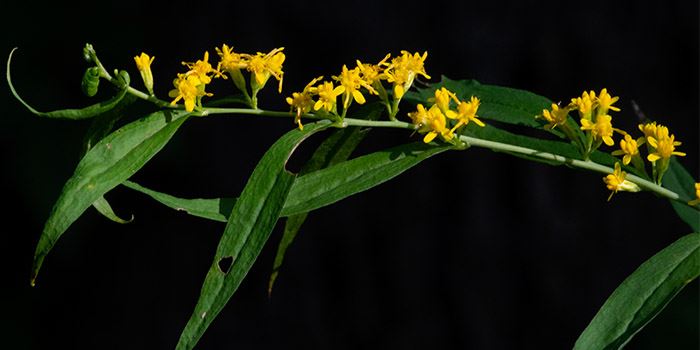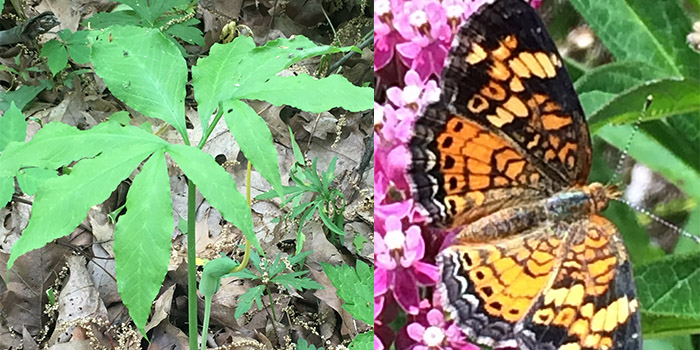Seven Months of Nature at Fallen Timbers Battlefield

Seven Months of Nature at Fallen Timbers Battlefield
Karen Menard
You think you might know a place, but you really don’t until you look deeper—with patience through time. A full experience takes more than just getting your steps in for the day. As constant change unfolds through the seasons, a bigger picture comes to light.
Back in April when I first started a walking routine around the loop trail at Fallen Timbers Battlefield, it was all too easy to take the park’s natural areas for granted. I marched forward down the trail, consumed mostly with visions of beating my last 1.5 or 3 mile finish time. My eyes darted between a wristwatch and landmarks like benches, buildings and signage. Thoughts were simply focused on fitness goals, mileage and a decent finish time.
And then spring began to unfold. As a nature lover, I couldn’t help but notice that there were more than just a few species of wildflowers starting to bloom along the woodland trail. The biodiversity caught my eye and became something to look forward to each week. Instead of counting steps and checking my watch, I found myself counting species and checking new finds. The trail came alive with the changes that occurred, and my walks became a great combination of fitness and nature—always looking forward to my next visit.
The seasons moved forward this year, and my trail observations connected me to the larger picture of nature’s cycles and biological relationships in both woodland and meadow habitats at this park. I was drawn back each week to see what else I could find. Here are the monthly highlights:
April: As the snow melts away, the forest floor awakens and reveals a spectacular spring wildflower display-- probably one of the best in northwest Ohio. Over thirty different species of blooms include yellow and white trout lily, Jacob’s ladder, purple cress and cut-leaved toothwort. These carpets of flowers are alive with a sea of energetic pollinators that include queen bumblebees, syrphid flies, sweat bees, mason bees, and many others. The insects at work can be seen and heard incessantly humming, fixated on blossoms.
May: Using this area as important stopover habitat, migratory songbirds like thrushes and warblers can be seen foraging for insects throughout the woodland. There is also an incredible diversity of blooming sedges in the forest and adjacent wet meadow, totaling approximately fifteen species.
June: Uniquely shaped sedge fruits (seeds) of all shapes and sizes ripen. Throughout the site, songbirds like willow flycatchers, scarlet tanagers, indigo buntings, field sparrows, wood thrushes and red-bellied woodpeckers are seen and heard. Wild grape blooms along the trail, and a walk in warm rain or on an evening when the air is full of moisture treats you to an intoxicatingly sweet scent.
July: The spring wildflower carpet that has faded away is now replaced with lush, green summer vegetation that covers the forest floor--complete with poison ivy, Virginia creeper, and Virginia knotweed (jumpseed). Small orange, pearl crescents as well as viceroy butterflies emerge and are commonly found alongside the trail in the open, meadow areas. Crescents use the abundant asters as host plants, while viceroy caterpillars chomp the nearby cottonwoods and willows. Close by, garter snakes actively hunt unsuspecting leopard frogs.
August: Armies of adult, red-legged grasshoppers seem to appear out of nowhere and almost always leap out of the way of human feet! Stands of richweed near the ravine bridge sport showy golden flowers and are a testament to high quality woodland habitat. Late in the month, flocking purple martins and swallows cavort above meadows as they ingest a plethora of insect swarms that rise with the degrees of the afternoon sun.
September: Congregations of migrating green darner dragonflies--each measuring three inches in length-- usurp a large part of the air space above the meadows as they hunt smaller unsuspecting insects in flight. Also, mixed flocks of blackbirds seeking invertebrate protein take over nearby cottonwood stands. The glowing purple blooms of the New England aster and the bright yellow hues of the goldenrods beckon hungry monarch butterflies fueling up on nectar for their southern journey. Diminutive DeKay’s brown snakes, resembling small twigs, are often seen basking in the sun along the trail.
October: This month holds a tremendous amount of surprise potential with vibrant fall colors popping at different times. As the red and burr oaks, shagbark hickories, basswoods, sugar maples and tulip trees turn their amazing colors, the constancy of change moves the seasons forward. Leaves full of nutrients float to the ground and decompose to become food for next year’s generations of spring wildflowers, trees and other woodland vegetation. Pollen and nectar from these plants will provide sustenance for queen bees and other pollinators to continue their next generations’ brood cycles. These insects will, in turn, feed our migratory and nesting birds, dragonflies, and leopard frogs (to name a few).
Lastly, blue jays-- the main dispersers of acorns—are busy with their important task of planting new generations of oak trees that forever change the future of our landscape. While blue jays depend on acorns for food, oak trees depend on blue jays to cache their acorns that eventually sprout and over time benefit many other species—insects, plants and the ecosystem at large. These acorns will sprout and grow new trees that add to the surprising array of over 300 species of plants at this park.
It is amazing to realize that all of this is located in the vicinity of just a 1.5 mile trail—in a small, 193 acre site. This winter or spring, consider choosing one Metropark trail to explore and spend some time on. You will be inspired by the natural wonders experienced throughout each season.
Fallen Timbers photos: Green Dragon (Arisaema dracontium) by Karen Menard; Pearl Crescent (Phyciodes tharos) by Karen Menard; Blue-stemmed Goldenrod (Solidago caesia) by Art Weber [top of the page]
